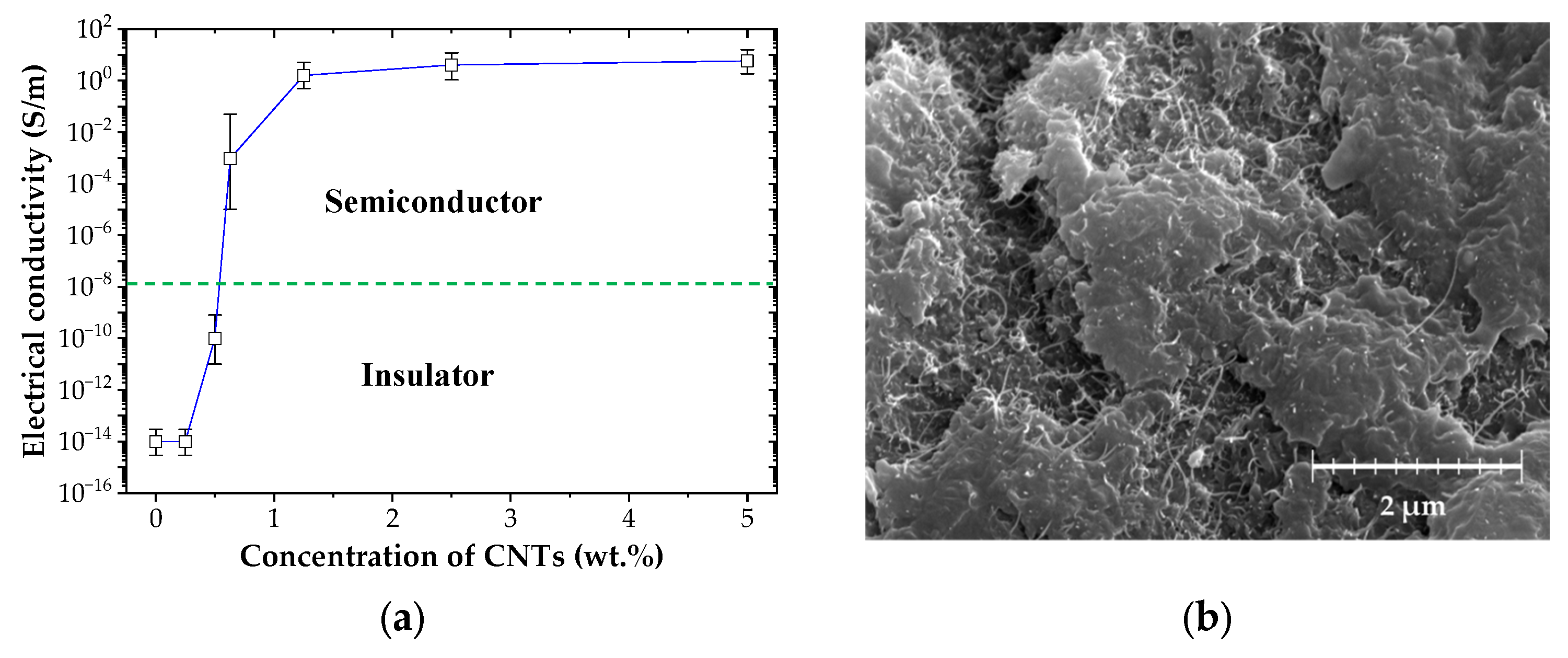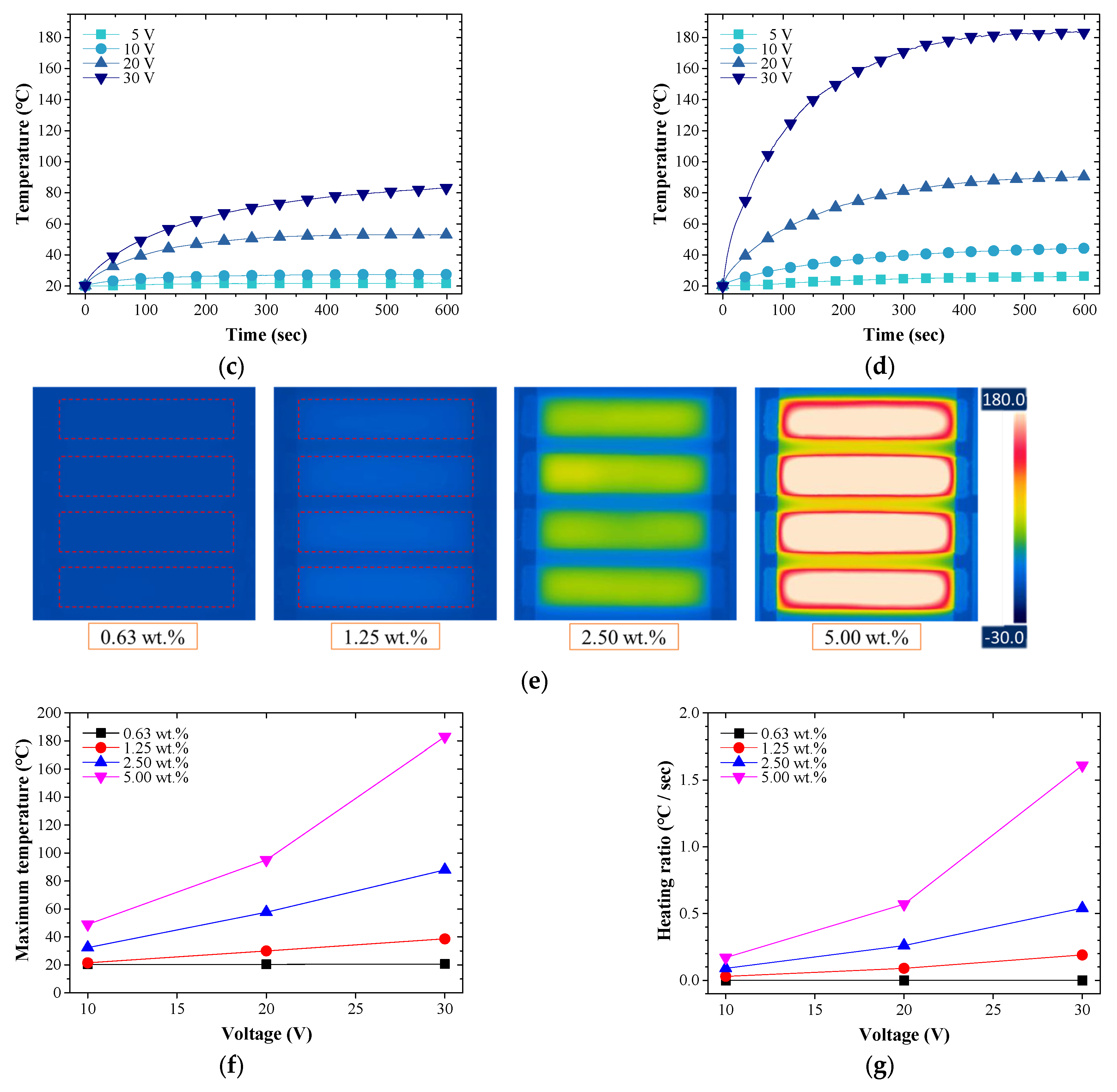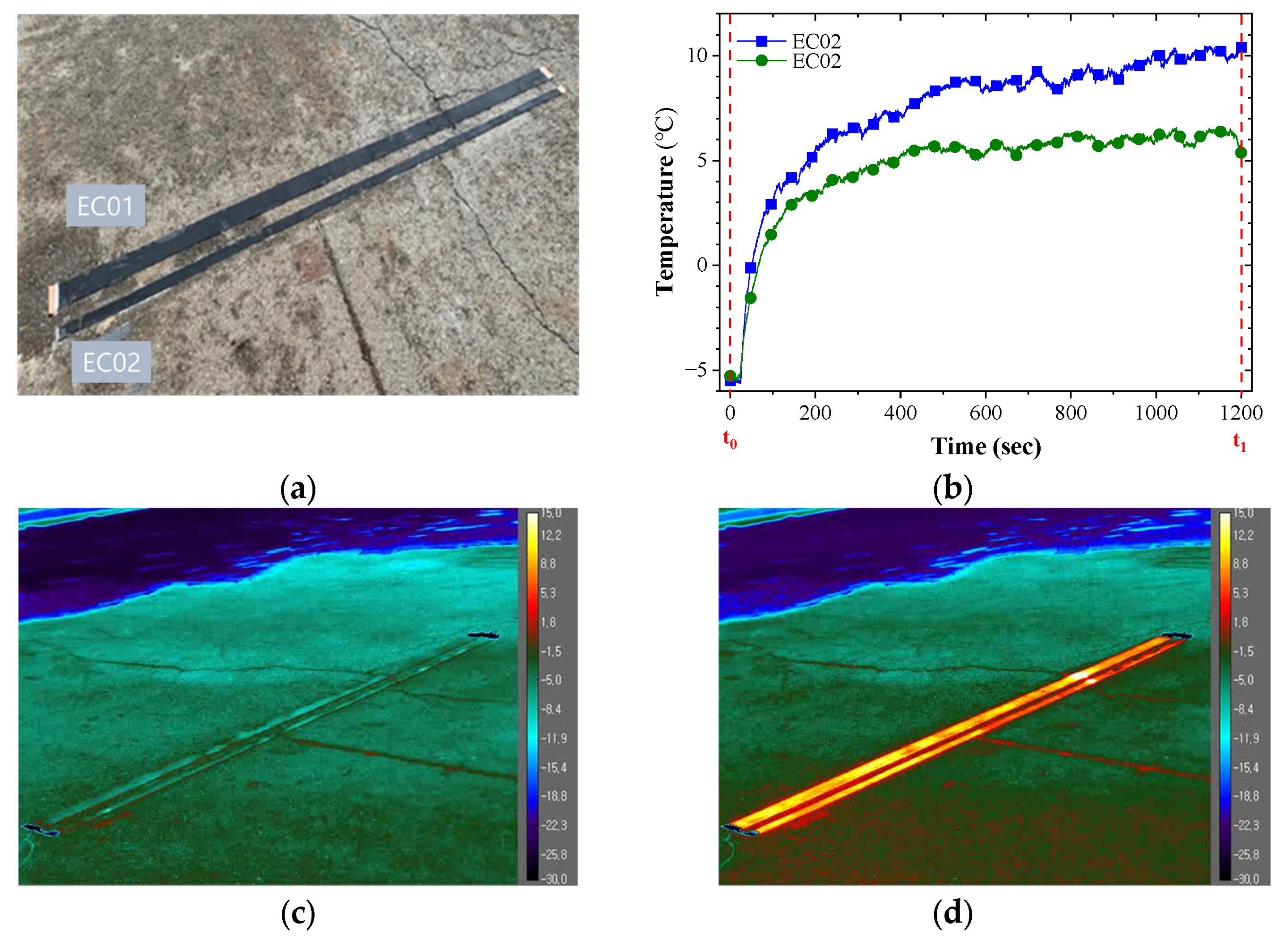Effect of Atmospheric Temperature on Epoxy Coating Reinforced with Carbon Nanotubes for De-Icing on Road Systems
Abstract
1. Introduction
2. Experimental
2.1. Materials
2.2. Fabrication Procedure
2.3. Characterization
3. Results and Discussion
3.1. Electrical Characteristics of CNT/EP Coating
3.2. Heating Characteristics of CNT/EP Coating at Room Temperature
3.3. Effect of Atmospheric Temperatures on Heating Performance of CNT/EP Coating
3.4. Application of Road Heating System
4. Conclusions
Author Contributions
Funding
Institutional Review Board Statement
Informed Consent Statement
Data Availability Statement
Conflicts of Interest
References
- Vitaliano, D.F. An economic assessment of the social costs of highway salting and the efficiency of substituting a new deicing material. J. Policy Anal. Manag. 1992, 11, 397–418. [Google Scholar] [CrossRef]
- Yu, W.; Yi, X.; Guo, M.; Chen, L. State of the art and practice of pavement anti-icing and de-icing techniques. Sci. Cold Arid Reg. 2014, 6, 14–21. [Google Scholar]
- Arabzadeh, A.; Ceylan, H.; Kim, S.; Gopalakrishnan, K.; Sassani, A. Super-hydrophobic coatings on asphalt concrete surfaces. Transport. Res. Rec. J. Transport. Res. Board. 2016, 2551, 10–17. [Google Scholar] [CrossRef]
- Arabzadeh, A.; Ceylan, H.; Kim, S.; Gopalakrishnan, K.; Sassani, A. Fabrication of polytetrafluoroethylene-coated asphalt concrete biomimetic surfaces: A nanomaterials based pavement winter maintenance approach. In Proceedings of the 2016 International Conference on Transportation and Development, Houston, TX, USA, 26–29 June 2016; pp. 54–64. [Google Scholar]
- Lai, Y.; Liu, Y.; Ma, D. Automatically melting snow on airport cement concrete pavement with carbon fiber grille. Cold Reg. Sci. Technol. 2014, 103, 57–62. [Google Scholar] [CrossRef]
- Ramakrishna, D.M.; Viraraghavan, T. Environmental impact of chemical deicers—A review. Water Air Soil Pollut. 2005, 166, 49–63. [Google Scholar] [CrossRef]
- Christopher, A.; Strong, J.E.; Mosher, P.A. Effect of deicing salts on metal and organic matter mobilization in roadside soils. Environ. Sci. Technol. 1992, 26, 703–709. [Google Scholar]
- Bäckström, M.; Karlsson, S.; Bäckman, L.; Folkeson, L.; Lind, B. Mobilisation of heavy metals by deicing salts in a roadside environment. Water Res. 2004, 38, 720–732. [Google Scholar] [CrossRef]
- Sanzo, D.; Hecnar, S.J. Effects of road de-icing salt (NaCl) on larval wood frogs (Rana sylvatica). Environ. Pollut. 2006, 140, 247–256. [Google Scholar] [CrossRef]
- Czerniawska-Kusza, I.; Kusza, G.; Duzynski, M. Effect of deicing salts on urban soils and health status of roadside trees in the Opole Region. Environ. Toxicol. 2004, 19, 296–301. [Google Scholar] [CrossRef]
- Cunningham, M.A.; Snyder, E.; Yonkin, D.; Ross, M.; Elsen, T. Accumulation of deicing salts in soils in an urban environment. Urban Ecosyst. 2008, 11, 17–31. [Google Scholar] [CrossRef]
- Karraker, N.E.; Gibbs, J.P.; Vonesh, J.R. Impacts of road deicing salt on the demography of vernal pool-breeding Amphibians. Ecol. Appl. 2016, 18, 724–734. [Google Scholar] [CrossRef] [PubMed]
- Shen, W.; Ceylan, H.; Gopalakrishnan, K.; Kim, S.; Taylor, P.C.; Rehmann, C.R. Life cycle assessment of heated apron pavement system operations. Transport. Res. Road Environ. 2016, 48, 316–331. [Google Scholar] [CrossRef]
- Wang, H.; Thakkar, C.; Chen, X.; Murrel, S. Life-cycle assessment of airport pavement design alternatives for energy and environmental impacts. J. Clean. Prod. 2016, 133, 163–171. [Google Scholar] [CrossRef]
- Xu, H.; Tan, Y. Modeling and operation strategy of pavement snow melting systems utilizing low-temperature heating fluids. Energy 2015, 80, 666–676. [Google Scholar] [CrossRef]
- Chang, C.; Ho, M.; Song, G.; Mo, Y.-L.; Li, H. A feasibility study of self-heating concrete utilizing carbon nanofiber heating elements. Smart Mater. Struct. 2009, 18, 127001. [Google Scholar] [CrossRef]
- Farcas, C.; Galao, O.; Navarro, R.; Zornoza, E.; Baeza, F.J.; Del Moral, B.; Pla, R.; Garcés, P. Heating and de-icing function in conductive concrete and cement paste with the hybrid addition of carbon nanotubes and graphite products. Smart Mater. Struct. 2021, 30, 045010. [Google Scholar] [CrossRef]
- Gomis, J.; Galao, O.; Gomis, V.; Zornoza, E.; Garces, P. Self-heating and deicing conductive cement. Experimental study and modeling. Constr. Build. Mater. 2015, 75, 442–449. [Google Scholar] [CrossRef]
- Pan, P.; Wu, S.; Xiao, Y.; Liu, G. A review on hydronic asphalt pavement for energy harvesting and snow melting. Renew. Sustain. Energy Rev. 2015, 48, 624–634. [Google Scholar] [CrossRef]
- Tuan, C.Y. Implementation of Conductive Concrete for Deicing (Roca Bridge); University of Nebraska: Lincoln, NE, USA, 2008. [Google Scholar]
- Wang, H.; Liu, L.; Chen, Z. Experimental investigation of hydronic snow melting process on the inclined pavement. Cold Reg. Sci. Technol. 2010, 63, 44–49. [Google Scholar] [CrossRef]
- Xu, H.; Wang, D.; Tan, Y.; Zhou, J.; Oeser, M. Investigation of design alternatives for hydronic snow melting pavement systems in China. J. Clean. Prod. 2018, 170, 1413–1422. [Google Scholar] [CrossRef]
- Han, B.G.; Yu, X.; Kwon, E. A self-sensing carbon nanotube/cement composite for traffic monitoring. Nanotechnology 2009, 20, 44. [Google Scholar] [CrossRef] [PubMed]
- Maurin, L.; Boussoir, J.; Rougeault, S.; Bugaud, M.; Ferdinand, P.; Landrot, A.G.; Grunevald, Y.H.; Chauvin, T. FBG-based smart composite bogies for railway applications. In Proceedings of the 2002 15th Optical Fiber Sensors Conference Technical Digest. OFS 2002 (Cat. No. 02EX533), Portland, OR, USA, 10 May 2002; pp. 91–94. [Google Scholar]
- Pujar, N.V.; Nanjundaradhya, N.V.; Sharma, R.S. Effect of graphene oxide nano filler on dynamic behaviour of GFRP composites. In Proceedings of the AIP Conference Proceedings, Lausanne, Switzerland, 19–21 March 2018; Volume 1943. [Google Scholar]
- Fouda, H.; Guo, L. The mechanical properties of CF/Epoxy resin composite with adding different types of CNTs. Int. J. Eng. Res. Technol. 2017, 6, 311–315. [Google Scholar]
- Mostovoy, A.; Yakovlev, A.; Tseluikin, V.; Lopukhova, M. Epoxy nanocomposites reinforced with functionalized carbon nanotubes. Polymers 2020, 12, 1816. [Google Scholar] [CrossRef] [PubMed]
- Isaji, S.; Bin, Y.; Matsuo, M. Electrical conductivity and self-temperature-control heating properties of carbon nanotubes filled polyethylene films. Polymer 2009, 50, 1046–1053. [Google Scholar] [CrossRef]
- Kumar, S.; Pimparkar, N.; Murthy, J.Y.; Alam, M.A. Self-consistent electrothermal analysis of nanotube network transistors. J. Appl. Phys. 2011, 109, 014315. [Google Scholar] [CrossRef]
- Chien, A.T.; Cho, S.; Joshi, Y.; Kumar, S. Electrical conductivity and Joule heating of polyacrylonitrile/carbon nanotube composite fibers. Polymer 2014, 55, 6896–6905. [Google Scholar] [CrossRef]
- Jang, S.H.; Park, Y.L. Carbon nanotube-reinforced smart composites for sensing freezing temperature and deicing by CNT/EP. Nanomater. Nanotechnol. 2018, 8, 1847980418776473. [Google Scholar] [CrossRef]
- Yum, S.G.; Yin, H.; Jang, S.H. Toward multi-functional road surface design with the nanocomposite coating of carbon nanotube modified polyurethane: Lab-scale experiments. Nanomaterials 2020, 10, 1905. [Google Scholar] [CrossRef]
- Prolongo, S.G.; Moriche, R.; Del Rosario, G.; Jiménez-Suárez, A.; Prolongo, M.G.; Ureña, A. Joule effect self-heating of epoxy composites reinforced with graphitic nanofillers. J. Polym. Res. 2016, 23, 189. [Google Scholar] [CrossRef]
- Redondo, O.; Prolongo, S.G.; Campo, M.; Sbarufatti, C.; Giglio, M. Anti-icing and de-icing coatings based Joule’s heating of graphene nanoplatelets. Compos. Sci. Technol. 2018, 164, 65–73. [Google Scholar] [CrossRef]
- Lee, S.J.; Jung, Y.J.; Park, J.W.; Jang, S.H. Temperature Detectable Surface Coating with Carbon Nanotube/Epoxy Composites. Nanomaterials 2022, 12, 2369. [Google Scholar] [CrossRef] [PubMed]
- Fang, Y.; Li, L.Y.; Jang, S.H. Calculation of electrical conductivity of self-sensing carbon nanotube composites. Compos. B Eng. 2020, 199, 108314. [Google Scholar] [CrossRef]
- Jang, S.H.; Li, L.Y. Self-sensing carbon nanotube composites exposed to glass transition temperature. Materials 2020, 13, 259. [Google Scholar] [CrossRef] [PubMed]
- Jang, S.H.; Kim, D.; Park, Y.L. Accelerated curing and enhanced material properties of conductive polymer nanocomposites by joule heating. Materials 2018, 11, 1775. [Google Scholar] [CrossRef]
- Kim, J.K.; Mai, Y.W. (Eds.) Engineered Interfaces in Fiber Reinforced Composites; Elsevier: Amsterdam, The Netherlands, 1998. [Google Scholar]
- Vertuccio, L.; Guadagno, L.; Spinelli, G.; Lamberti, P.; Zarrelli, M.; Russo, S.; Iannuzzo, G. Smart coatings of epoxy based CNTs designed to meet practical expectations in aeronautics. Compos. Part B Eng. 2018, 147, 42–46. [Google Scholar] [CrossRef]
- Xin, X.; Liang, M.; Yao, Z.; Su, L.; Zhang, J.; Li, P.; Sun, C.; Jiang, H. Self-sensing behavior and mechanical properties of carbon nanotubes/epoxy resin composite for asphalt pavement strain monitoring. Constr. Build. Mater. 2020, 257, 119404. [Google Scholar] [CrossRef]
- Cataldo, A.; Biagetti, G.; Mencarelli, D.; Micciulla, F.; Crippa, P.; Turchetti, C.; Pierantoni, L.; Bellucci, S. Modeling and electrochemical characterization of electrodes based on epoxy composite with functionalized nanocarbon fillers at high concentration. Nanomaterials 2020, 10, 850. [Google Scholar] [CrossRef]
- Cortés, A.; Romate, X.F.S.; Jiménez-Suárez, A.; Campo, M.; Prolongo, M.G.; Ureña, A.; Prolongo, S.G. 3D printed anti-icing and de-icing system based on CNT/GNP doped epoxy composites with self-curing and structural health monitoring capabilities. Smart Mater. Struct. 2020, 30, 025016. [Google Scholar] [CrossRef]
- Liang, S.; Wang, H.; Tao, X. Multiwalled carbon nanotube/cationic cellulose nanofibril electrothermal films: Mechanical, electrical, electrothermal, and cycling performances. Wood Sci. Technol. 2021, 55, 1711–1723. [Google Scholar] [CrossRef]
- Farcas, C.; Galao, O.; Vertuccio, L.; Guadagno, L.; Romero-Sánchez, M.D.; Rodríguez-Pastor, I.; Garcés, P. Ice-prevention and de-icing capacity of epoxy resin filled with hybrid carbon-nanostructured forms: CNT/EP by Joule effect. Nanomaterials 2021, 11, 2427. [Google Scholar] [CrossRef]
- Lee, T.W.; Jeong, Y.G. Regenerated cellulose/multiwalled carbon nanotube composite films with efficient electric heating performance. Carbohydr. Polym. 2015, 133, 456–463. [Google Scholar] [CrossRef]
- An, J.E.; Jeong, Y.G. Structure and electric heating performance of graphene/epoxy composite films. Eur. Polym. J. 2013, 49, 1322–1330. [Google Scholar] [CrossRef]
- Lee, H.B.; Veerasubramani, G.K.; Lee, K.S.; Lee, H.; Han, T.H. Joule heating-induced faradaic electrode-decorated graphene fibers for flexible fiber-shaped hybrid supercapacitor with high volumetric energy density. Carbon 2022, 198, 252–263. [Google Scholar] [CrossRef]
- Wang, B.; Wang, G.F.; Jiang, S.S.; Zhang, K.F. Effect of pulse current on thermal performance and deep drawing of SiCp/2024Al composite sheet. Int. J. Adv. Manuf. Technol. 2013, 67, 623–627. [Google Scholar] [CrossRef]
- Zhou, B.; Han, X.; Li, L.; Feng, Y.; Fang, T.; Zheng, G.; Wang, B.; Dai, K.; Liu, C.; Shen, C. Ultrathin, flexible transparent Joule heater with fast response time based on single-walled carbon nanotubes/poly(vinyl alcohol) film. Compos. Sci. Technol. 2019, 183, 107796. [Google Scholar] [CrossRef]
- Zhang, X.; Wang, X.; Lei, Z.; Wang, L.; Tian, M.; Zhu, S.; Xiao, H.; Tang, X.; Qu, L. Flexible MXene-decorated fabric with interwoven conductive networks for integrated Joule heating, electromagnetic interference shielding, and strain sensing performances. ACS Appl. Mater. Interfaces 2020, 12, 14459–14467. [Google Scholar] [CrossRef]
- Zhou, B.; Li, Z.; Li, Y.; Liu, X.; Ma, J.; Feng, Y.; Zhang, D.; He, C.; Liu, C.; Shen, C. Flexible hydrophobic 2D Ti3C2Tx-based transparent conductive film with multifunctional self-cleaning, electromagnetic interference shielding and joule heating capacities. Compos. Sci. Technol. 2021, 201, 108531. [Google Scholar] [CrossRef]
- Sun, Y.; Ding, R.; Hong, S.Y.; Lee, J.; Seo, Y.K.; Nam, J.D.; Suhr, J. MXene-xanthan nanocomposite films with layered microstructure for electromagnetic interference shielding and Joule heating. Chem. Eng. J. 2021, 410, 128348. [Google Scholar] [CrossRef]
- Jeong, Y.G.; An, J.E. Effects of mixed carbon filler composition on electric heating behavior of thermally-cured epoxy-based composite films. Compos. Part A Appl. Sci. Manuf. 2014, 56, 1–7. [Google Scholar] [CrossRef]
- Wang, F.X.; Liang, W.Y.; Wang, Z.Q.; Yang, B.; He, L.; Zhang, K. Preparation and property investigation of multi-walled carbon nanotube (MWCNT)/epoxy composite films as high-performance electric heating (resistive heating) element. Express Polym. Lett. 2018, 12, 285–295. [Google Scholar] [CrossRef]
- Tang, P.; Zhang, R.; Shi, R.; Bin, Y. Synergetic effects of carbon nanotubes and carbon fibers on electrical and self-heating properties of high-density polyethylene composites. J. Mater. 2015, 50, 1565–1574. [Google Scholar] [CrossRef]
- Prolongo, S.G.; Moriche, R.; Jiménez-Suárez, A.; Delgado, A.; Ureña, A. Printable self-heating coatings based on the use of carbon nanoreinforcements. Polym. Compos. 2020, 41, 271–278. [Google Scholar] [CrossRef]
- Chu, H.; Zhang, Z.; Liu, Y.; Leng, J. Self-heating fiber reinforced polymer composite using meso/macropore carbon nanotube paper and its application in deicing. Carbon 2014, 66, 154–163. [Google Scholar] [CrossRef]
- Xu, C.; Xu, S.; Eticha, R.D. Experimental investigation of thermal performance for pulsating flow in a microchannel heat sink filled with PCM (paraffin/CNT composite). Energy Convers. Manag. 2021, 236, 114071. [Google Scholar] [CrossRef]
- Brian, P.T.; Reid, R.C.; Shah, Y.T. Frost deposition on cold surfaces. Ind. Eng. Chem. Fund. 1970, 9, 375–380. [Google Scholar] [CrossRef]
- Na, B.; Webb, R.L. A fundamental understanding of factors affecting frost nucleation. Int. J. Heat Mass Transf. 2003, 46, 3797–3808. [Google Scholar] [CrossRef]
- Liebscher, M.; Tzounis, L.; Junger, D.; Dinh, T.T.; Mechtcherine, V. Electrical Joule heating of cementitious nanocomposites filled with multi-walled carbon nanotubes: Role of filler concentration, water content, and cement age. Smart Mater. Struct. 2020, 29, 125019. [Google Scholar] [CrossRef]
- Li, Q.; Xue, Q.Z.; Gao, X.L.; Zheng, Q.B. Temperature dependence of the electrical properties of the carbon nanotube/polymer composites. Express Polym. Lett. 2009, 3, 769–777. [Google Scholar] [CrossRef]









Disclaimer/Publisher’s Note: The statements, opinions and data contained in all publications are solely those of the individual author(s) and contributor(s) and not of MDPI and/or the editor(s). MDPI and/or the editor(s) disclaim responsibility for any injury to people or property resulting from any ideas, methods, instructions or products referred to in the content. |
© 2023 by the authors. Licensee MDPI, Basel, Switzerland. This article is an open access article distributed under the terms and conditions of the Creative Commons Attribution (CC BY) license (https://creativecommons.org/licenses/by/4.0/).
Share and Cite
Lee, S.-J.; Jung, Y.-J.; Cho, C.; Jang, S.-H. Effect of Atmospheric Temperature on Epoxy Coating Reinforced with Carbon Nanotubes for De-Icing on Road Systems. Nanomaterials 2023, 13, 2248. https://doi.org/10.3390/nano13152248
Lee S-J, Jung Y-J, Cho C, Jang S-H. Effect of Atmospheric Temperature on Epoxy Coating Reinforced with Carbon Nanotubes for De-Icing on Road Systems. Nanomaterials. 2023; 13(15):2248. https://doi.org/10.3390/nano13152248
Chicago/Turabian StyleLee, Seung-Jun, Yu-Jin Jung, Chunhee Cho, and Sung-Hwan Jang. 2023. "Effect of Atmospheric Temperature on Epoxy Coating Reinforced with Carbon Nanotubes for De-Icing on Road Systems" Nanomaterials 13, no. 15: 2248. https://doi.org/10.3390/nano13152248
APA StyleLee, S.-J., Jung, Y.-J., Cho, C., & Jang, S.-H. (2023). Effect of Atmospheric Temperature on Epoxy Coating Reinforced with Carbon Nanotubes for De-Icing on Road Systems. Nanomaterials, 13(15), 2248. https://doi.org/10.3390/nano13152248






